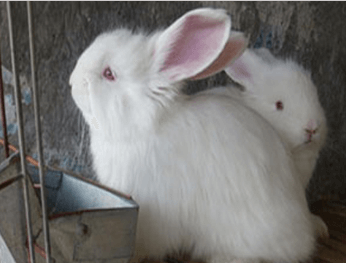長(zhǎng)毛兔養(yǎng)殖新技術(shù)
 發(fā)布日期:2020-05-28
來(lái)源:http://guijingwen.cn 發(fā)布人:admin
發(fā)布日期:2020-05-28
來(lái)源:http://guijingwen.cn 發(fā)布人:admin
目前長(zhǎng)毛兔的兔毛產(chǎn)品更加傾向于往紡高支紗、做輕薄產(chǎn)品這個(gè)方向。一方面符合服裝向輕薄化發(fā)展的潮流,另外也易于解決原兔毛產(chǎn)品存在的掉毛、起球、縮水三大難題,因此對(duì)細(xì)度的要求較高。
長(zhǎng)毛兔的養(yǎng)毛期要根據(jù)毛紡市場(chǎng)的需求靈活掌握。
At present, the rabbit hair products of long wool rabbit are more inclined to spinning high count yarn and making light and thin products. On the one hand, it is in line with the trend of the development of light and thin clothing. On the other hand, it is easy to solve the three problems existing in the original rabbit hair products, namely, shedding, pilling and shrinkage. Therefore, it requires high fineness. The raising period of long wool rabbit should be controlled flexibly according to the demand of wool market.
山東省蒙陰鑫華種兔場(chǎng)對(duì)不同養(yǎng)毛期兔毛生長(zhǎng)速度和纖維細(xì)度進(jìn)行測(cè)定,實(shí)際生產(chǎn)中可根據(jù)各地不同的氣候特點(diǎn)及市場(chǎng)需求,適當(dāng)調(diào)整養(yǎng)毛期,晚春早夏季節(jié),采用50~70天的養(yǎng)毛期,兔毛可達(dá)到紡織要求。
The growth speed and fiber fineness of rabbit hair in different raising periods were measured in Xinhua rabbit farm of Mengyin, Shandong Province. In actual production, according to different climatic characteristics and market demand, the raising period can be adjusted appropriately. From late spring to early summer, the raising period of 50-70 days is adopted, and the rabbit hair can meet the textile requirements.
目前在生產(chǎn)過(guò)程中使用的大宗飼料原料主要為玉米、餅粕類、農(nóng)作物秸稈和部分工業(yè)副產(chǎn)品等,隨著工業(yè)用玉米用量的增加和畜牧業(yè)發(fā)展對(duì)飼料原料需求的增加,養(yǎng)殖業(yè)面臨飼料上漲、飼料來(lái)源緊張和飼料質(zhì)量難以控制的問題,特別是粗飼料,很難滿足長(zhǎng)毛兔生產(chǎn)的需要,因此,必須開發(fā)非常規(guī)飼料。
At present, the bulk feed raw materials used in the production process are mainly corn, cake, crop straw and some industrial by-products. With the increase of industrial corn consumption and the increase of demand for feed raw materials in the development of animal husbandry, the breeding industry is facing the problems of rising feed price, shortage of feed sources and difficult to control feed quality, especially the coarse feed, which is difficult to meet the long haired rabbit Therefore, it is necessary to develop unconventional feed.
食用菌渣為食用菌產(chǎn)菇后的廢料,食用菌栽培原料經(jīng)微生物發(fā)酵后,部分物質(zhì)被降解,可適當(dāng)添加用作畜禽飼料。比如金針菇菌渣與小麥麩皮相比,粗蛋白略低,粗纖維含量接近,但菌渣為有益菌發(fā)酵產(chǎn)品,含有更多的菌體蛋白和非蛋白氮,更適宜兔的消化和利用,可完全替代小麥麩皮。
The residue of edible mushroom is the waste after the production of edible mushroom. After the fermentation of the raw material of edible mushroom, part of the material is degraded and can be properly added as animal feed. For example, compared with wheat bran, the crude protein of Flammulina velutipes dregs is slightly lower and the crude fiber content is similar, but the dregs are beneficial fermentation products, containing more bacterial protein and non protein nitrogen, which are more suitable for the digestion and utilization of rabbits and can completely replace wheat bran.
長(zhǎng)毛兔剪毛方法的改進(jìn)是將傳統(tǒng)的剪毛方法加以改進(jìn),該方法剪毛速度會(huì)更快。利用這種方法,熟練剪毛工每只兔的剪毛時(shí)間可節(jié)省3~5分鐘,既可提高勞動(dòng)效率,又可提高兔毛的質(zhì)量。
The improvement of long wool rabbit's shearing method is to improve the traditional shearing method, which will cut faster. By using this method, skilled shearers can save 3-5 minutes of shearing time for each rabbit, which can not only improve labor efficiency, but also improve the quality of rabbit hair.



 發(fā)布日期:2020-05-28
來(lái)源:http://guijingwen.cn 發(fā)布人:admin
發(fā)布日期:2020-05-28
來(lái)源:http://guijingwen.cn 發(fā)布人:admin